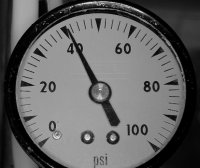Thanks for everyone's replies, learning a lot here. That said, I still do not have a definitive answer as to why my pump is filling my 20 gal pressure tank w/ a 6.2 gal drawdown in 26 seconds. I tinkered with the pressure switch, and the tube is clear, and it responds to adjustments as it should by turning the nuts. When returning to where it was originally, the pump is still kicking on at 30 psi, and off at 50 as it should. I re-drained the system to get the water pressure to 0, and the pressure tank is still right on at 28 psi (been 2-3 weeks since adding air now). Drawdown was still 5.25 gallons, so about a gallon short. Shook the tank again when empty, and still no water sloshing. Pressure at all faucets is great (as usual), and outside of the short fill time, system is working great. I honestly do not know what my cycle time was before repairing the check valve, but I don't see why it would have changed now. And I have lived in my house for ~10 years, so I doubt that a pump cycling this way would last that long, and who knows how long it has been in the well before that (house was built in 1989). So the math doesn't lie, it looks like my pump is producing ~11 gpm, which would mean I would need a 11+ gallon drawdown capacity to keep the minimum 1 minute run time, so looking at a 40+ gallon tank. As I mentioned in my original post, I have no info on my pump. My Amtrol 20 gallon pressure tank is original to the house and is dated 1989, so well undersized for 30+ yrs. I've started shopping around for a 40 gal replacement. I can go ~ 5-6 feet high, but not much more that 15-16 inches wide due to a narrow area where the tank needs to fit. CSV sounds interesting, but not 100% sure that is what I'd want to go with here with a tiny tank. I'm stumped...anything else to check before replacing the tank with a bigger one?

